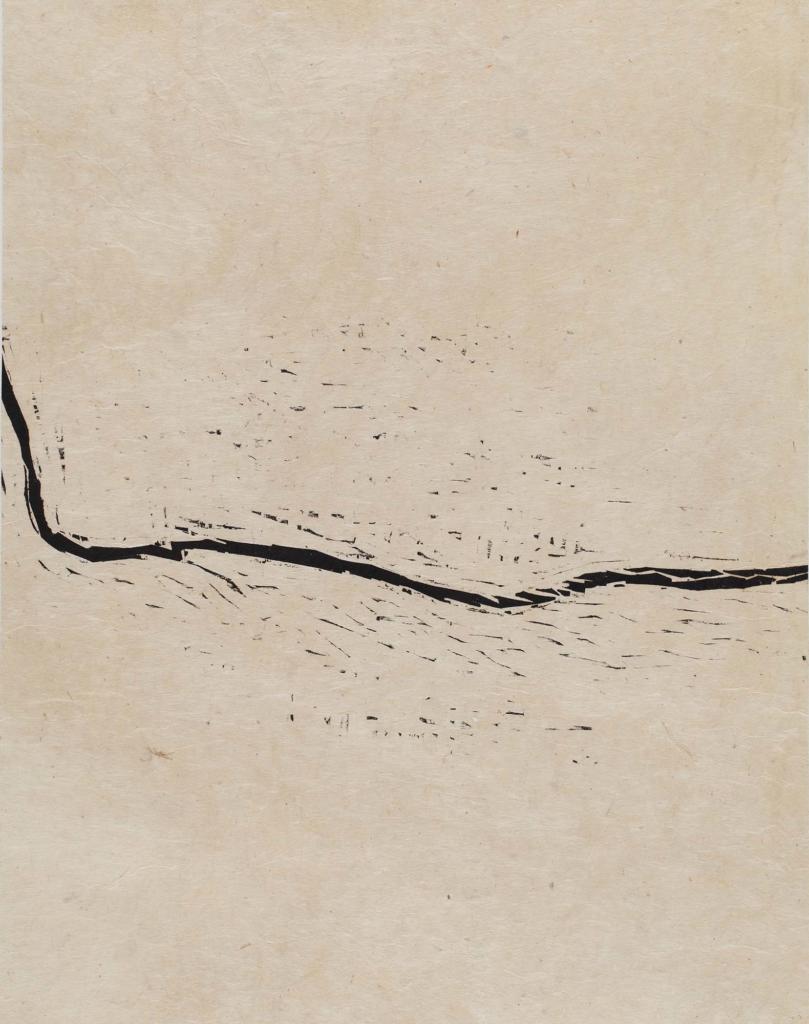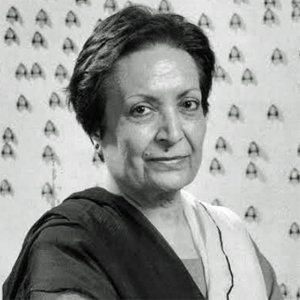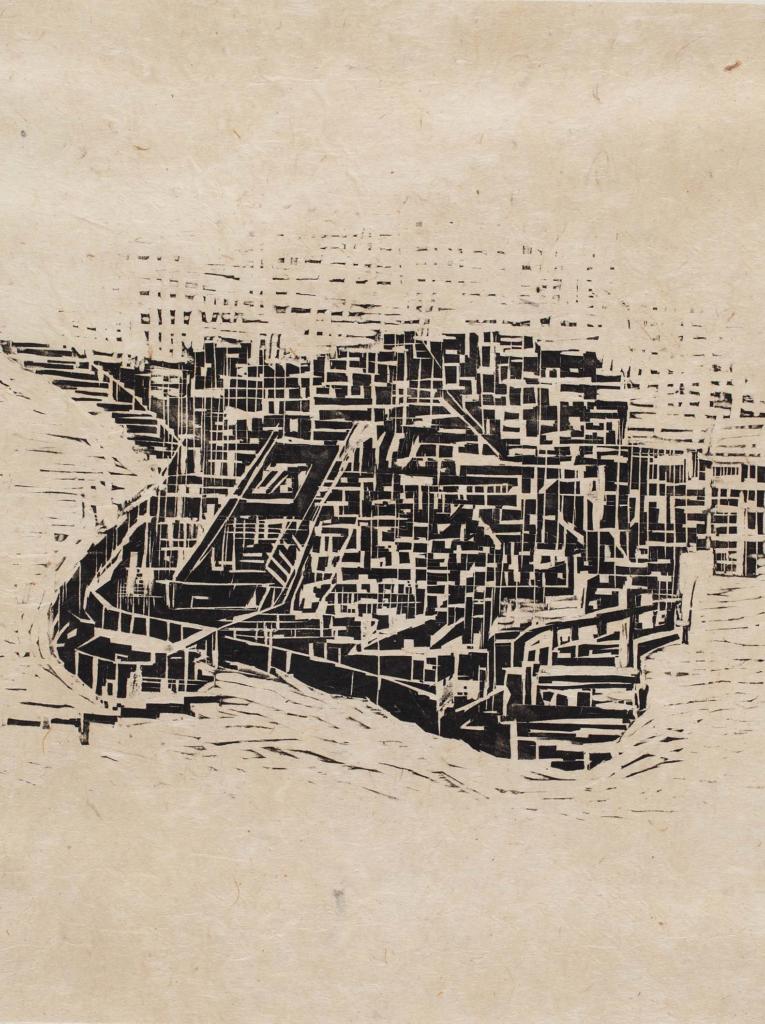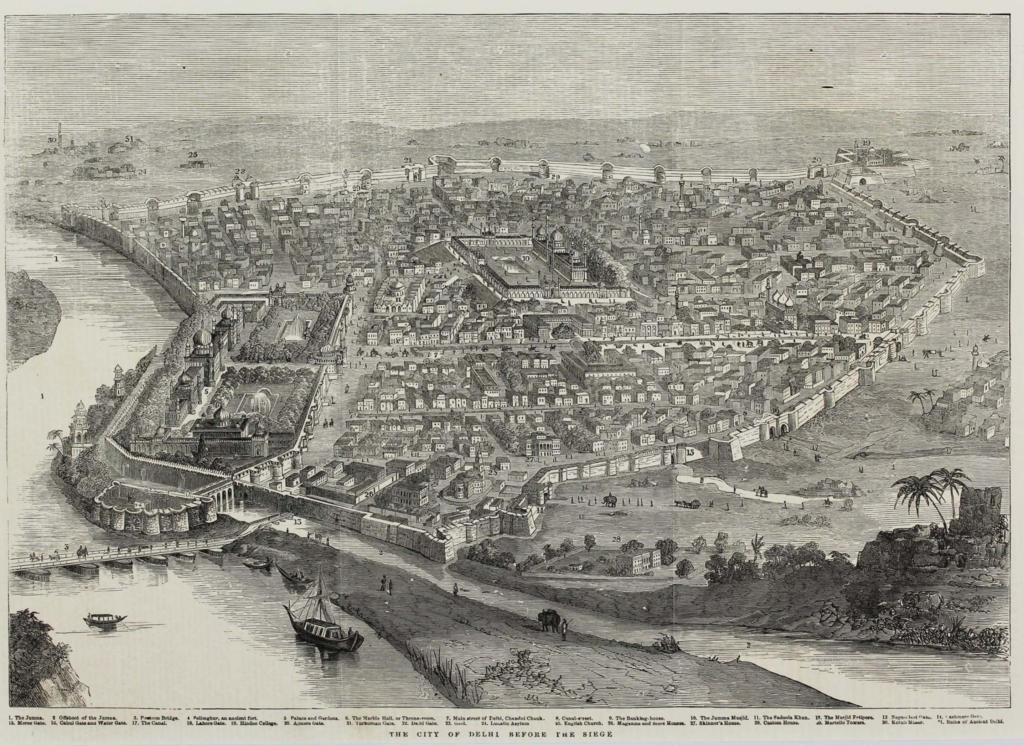
‘Delhi III’, 2000, woodcut print with black ink on handmade paper pasted on cartridge paper, by Zarina Hashmi © Sarmaya Arts Foundation
Delhi II & III were part of our show Shifting Selves – Between meaning, mythology & mirage
“I do not feel at home anywhere, but the idea of home follows me wherever I go. In dreams and on sleepless nights, the fragrance of the garden, image of the sky, and the sound of language returns. I go back to the roads I have crossed many times. They are my companions and my solace.”
From an artist statement by Zarina Hashmi for her residency at The Asian/Pacific/American Institute at New York University
Witness to the horrors of the India-Pakistan partition at the tender age of 10, the artist dedicated her decades-long career to exploring the idea of home and belonging, and the pains of displacement. Zarina (she went by her first name) was born in Aligarh, where her father was professor of history at Aligarh Muslim University. Her first encounter with displacement came during the Partition, when her family moved to a refugee camp in Delhi. A decade later, when they moved to Lahore and later to Karachi, Zarina stayed back to attend university in Aligarh. Here, she married Indian diplomat Saad Hashmi and the couple moved to Bangkok. This would be the beginning of many moves across the globe for Zarina. At nearly every place she made a home, she sought out artistic practices to master and they too travelled with her.

Zarina Hashmi, image via Wikipedia Creative Commons/Fair use
At Bangkok, Zarina was introduced to Japanese woodblock printing. She continued her study of printmaking at the famous Atelier17 when the couple moved to Paris in 1963. Their next move was to Bonn, Germany, where she learned silkscreen printing. In 1974, Zarina was awarded a Japan Foundation Grant for a two-week fellowship studying woodblock techniques with the printmaking master, Toshi Yoshida. The Hashmis then moved to New York and when Saad eventually returned to Delhi, Zarina stayed back to live and practice in the city.
In her biography, New York is not associated with a specific art practice like the other cities were but it gave her something equally important: a sense of home. Of her adopted home Zarina said, “I wouldn’t have been able to do or live the way I have in any other country. I decided to make America my home; looking back, I think it was the best decision at the time. America does provide you with opportunities, you can be who you are or make your own identity. You can be yourself.” More than anything, even more than being an artist, Zarina wanted to be herself.
Growing up in Aligarh, Zarina didn’t display an artistic disposition. Rather, she loved mathematics, which she eventually studied at university hoping to be an engineer or an architect. But she realised what she truly enjoyed was the geometry involved in architecture and construction. She said it simply: “I like to draw straight lines.” She grew up surrounded by and adoring the symmetry and patterns inherent to Islamic architecture – she spoke often of the great impact that the ruins of Fatehpur Sikri had on her. She believed it was here that she first encountered minimalism. Accordingly, architectural floor plans, the layouts of rooms and other elements of houses, like ceiling fans, doors etc. came to be part of her powerful visual language. For her celebrated 1999 series of 36 woodcuts titled Home is A Foreign Place, Zarina identified a series of words associated with memories of her childhood home such as “threshold”, “courtyard”, “entrance”, “rain” and “hot breeze.” She had these transcribed by an Urdu calligrapher in Pakistan and produced her visual responses to each – the clean lines of a door, a spread of the night sky as viewed from her courtyard etc.
As with architectural plans of houses, maps too were often part of Zarina’s work. She was deeply interested in geography and in how cities were laid out. “My father took me on a joyride in a plane over Aligarh when I was a child, and I saw how the city was laid out,” she said in an interview for MoMA. “I sat in his lap—it must have still been during British India. I flew a glider later, myself, in Delhi.” A lot of her works show aerial views of cities. Her series Cities I Called Home (2010) features meticulous woodcut aerial maps of several cities she has lived in over the course of her life, while her series Delhi (2000) brings together three maps of the city, two of which are in the Sarmaya collection. Of these, Delhi III outlines only River Yamuna, the lifeline of Delhi. There is tremendous purpose to Zarina’s painstaking documentation. “Memory is the only lasting possession we have,” she has said. Her laborious woodcuts are memory made tangible.
Language was just as central to Zarina’s work as were her powerful straight lines. Many of her pieces were accompanied by words – her own and that of others. Flight log, a cast paper sculpture she created in 1987, contains four lines of text.
I tried to fly
Got caught in the thermal
Could never go back
Having lost the place to land.
Later, she said, “In those four lines I wrote my autobiography.”
In her 2004 portfolio of woodblock and metalcut prints, Letters from Home, she used original letters that her sister Rani sent from Pakistan reporting on all sorts of developments in the family. These letters are layered over architectural plans of their childhood home. “After Partition, it was hard to cross into Pakistan as an Indiancitizen. My sister Rani’s letters connected me to the family I had been separated from,” Zarina said of this series. “Many people have asked why I titled this portfolio Letters from Home when I have never lived in Pakistan. For me, home is not a place. It is wherever the people you care about most are waiting for you.” There is unbearable tenderness and pain within the clean lines of floor plans in this series. It bears intimate messages in Urdu such as “my little sister, please don’t cry, but when you come to the house it feels like home and I missed you very much when you didn’t visit this spring.”

‘Delhi II’, 2000, woodcut print with black ink on handmade paper pasted on cartridge paper, by Zarina Hashmi © Sarmaya Arts Foundation

‘The City of Delhi Before the Siege’, 1858, Illustrated London News © Sarmaya Arts Foundation
Zarina cherished poetry. Living in New York, she lamented the loss of her beloved Urdu and would listen to Urdu poetry recitals on YouTube before going to bed. As can be expected, poetry often influences, enhances, and extends her work. In one of her works, she juxtaposes Meer Taqi Meer’s ghazal over a map of Delhi. The lines read:
Kya bood-o-baash poochho ho poorab ke saakino;
hamko ghareeb jaan ke hans hans pukaar ke
Dilli jo ek shahar tha aalam mein intakhaab;
rahte the muntakhib hi jahan rozgaar ke
Usko falak ne loot ke veeran kar diya;
ham rahnewale hein usi ujare dayar ke
(Why ask where I come from, O dwellers of the East,
Knowing my homelessness you laugh as you taunt.
Delhi that was once a select city in the world,
Where only the chosen lived of every trade;
Then the heavens looted it and left it desolate,
I am a citizen, of that ruined place.)
Meer’s pain at the plunder of his beloved Delhi in the 18th-century by Nader Shah and Ahmad Shah Abdali shone through most of his work. In her Delhi series, Zarina too laments the loss of an era and of a Delhi she loved. Her inspiration for the work was a 19th-century engraving, part of the Sarmaya collection, that showed the city as it stood just before the siege of 1857 lay waste to this magnificent landscape. It was first published in the Illustrated London News of 1858, already tinged with nostalgia and a certain wistfulness. There once stood a city like this, the artist seems to say. But no more.
Zarina died last April at the age of 83 in London. Not a city that contributed to her dazzling, multi-disciplinary art practice, or one she evoked lovingly in her work. But hopefully a place where she finally found home.
References
Art Asia Pacific – Memories of Zarina Hashmi
Home is a foreign place, Met Museum
Letters from Home, Google Arts & Culture
In Pictures: Zarina Hashmi’s Letters from Home, Architectural Review
Zarina’s Obituary by Asian/Pacific/American Institute at NYU



